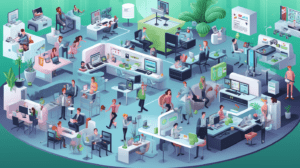Top Reasons Mobile Hairdressers, Need Great CRM Software

Ah, the life of mobile hairdressers, barbers and stylists! Zipping from one location to another, transforming retirement homes into fashion runways, and turning private parties into glam fests. But let’s face it, while your scissors might be sharp, dealing with payments can sometimes be… well, hairy. 🙈
Enter SellingLane, the ultimate sidekick for mobile hairdressers. It’s like having your own personal assistant, but instead a $30 an hour, it’s $6 a month.
On-the-Go Payments? Snip-Snip Hooray! 💳✂️

With SellingLane, you can accept payments anywhere, anytime. Whether you’re in the cozy living room of Mrs. Smith at the retirement home or amidst the lively chatter of a bachelorette party, your payment solution is always at your fingertips. No more “I’ll pay you next time” or chasing down checks.
In the world of business, cash flow is the hairstyle, and SellingLane is the hairspray that keeps it perfectly in place.”
– Fictitious Hair Guru,
Safety First, Just Like That Hair Dye Patch Test! 🔒
SellingLane ensures that all transactions are secure. We understand that your client’s trust is as precious as that perfect hair color shade. So, while you focus on the highlights, we’ve got the security covered.
Instant Receipts: Because No One Likes Waiting… Except for Hair Masks 🕐
Once the payment is made, SellingLane instantly sends a receipt to your client. It’s faster than you can say “blow-dry”!
“Time is of the essence, especially when you have curlers on!”
– Sandy Welland, Ontario
Multiple Payment Options: More Choices than Hairdos! 💰
Cash, card, digital wallets – SellingLane supports them all. It’s like offering your clients an array of hairstyles; there’s something for everyone!
The Art of Route Planning for Mobile Hairdressers/Barbers

For mobile hairdressers, every snip, style, and shade is a testament to their craft. But beyond the scissors and hair dyes, there’s another crucial aspect that determines their success: route planning. Efficient route planning is the unsung hero behind every successful mobile hairdresser. It’s the difference between a day that flows seamlessly and one that feels like you’re caught in a never-ending tangle of traffic and time constraints.
Imagine this: You have back-to-back appointments across town. One at a bustling city center apartment, another at a serene suburban home, and yet another at a lively local retirement community. Without effective route planning, you risk running late, getting caught in traffic jams, or worse, missing appointments altogether. Such hiccups not only disrupt your schedule but can also tarnish your professional reputation. On the flip side, a well-planned route ensures punctuality, reduces fuel costs, and allows for unexpected delays, ensuring you arrive at each location calm, composed, and ready to work your magic. In essence, for mobile hairdressers, efficient route planning isn’t just about getting from point A to B; it’s about ensuring consistent, top-notch service, one client at a time.
The Magic of Menu Selling for Barbers and Hairstylists
Each client comes with their own set of preferences, needs, and hair dreams. But while individualized service is crucial, there’s also immense power in structured choice. Enter menu selling, a concept that’s revolutionizing the way barbers and hairstylists operate.
Menu selling, at its core, is about offering clients a clear set of choices. Think of it as a curated list, much like a restaurant menu, where each option is designed to cater to different needs and budgets. For hairstylists, this could mean a simple breakdown: a ‘cut only’ for the quick trims, a ‘wash and cut’ for those looking for a fresh feel, or a comprehensive ‘color, wash, and cut’ for a complete makeover.
Here’s why this approach is a game-changer:
- Clarity for Clients: With a clear menu, clients know exactly what they’re getting. There’s no ambiguity, no surprise costs. They can choose a service that aligns with their needs and budget.
- Efficiency: By knowing in advance what the client wants, hairstylists can allocate their time more efficiently. If it’s just a trim, they can slot in another appointment right after. If it’s a color job, they can prepare in advance.
- Upselling Opportunities: A well-structured menu can subtly encourage clients to opt for additional services. For instance, a client coming in for just a cut might consider a wash as well when they see it as a combo option.
- Professional Image: Presenting services in a menu format exudes professionalism. It shows clients that the hairstylist or barber is organized, transparent, and values their time.
In your business, trends change with the wind, but menu selling offers a way to keep a touch of stability and structure. It’s a win-win, ensuring clients get the best service tailored to their needs, while hairstylists can optimize their time and skills. So, the next time a client walks in, instead of the usual “What are we doing today?”, imagine the impact of presenting them with a menu of choices, each tailored to make them look and feel their best. 🌟✂️📋
A Digital Storefront for Mobile Hairstylists: Your Business Website

In today’s digital age, having an online presence isn’t just an option; it’s a necessity. For mobile hairstylists, who are always on the move, this is even more crucial. The website feature of Selling Lane offers a perfect solution. Think of it as your digital business card, portfolio, and appointment booker, all rolled into one.
With Selling Lane, mobile hairstylists get a sleek, professional website that’s easy to set up and manage. Showcase your work, list your services, and even allow clients to book appointments directly through the site. No more missed calls or back-and-forth texts. Plus, with the added advantage of being mobile-optimized, clients can access your site, check your availability, and book their next appointment, all from the convenience of their smartphone. It’s a game-changer for hairstylists on the go, ensuring you’re always connected, always accessible, and always ready to make the next client look fabulous. 💇♀️📱🌐
Final Brushstrokes 🖌️
Staying a cut above the rest (pun intended) is no mere snip of the scissors. 🤭💇♂️ That’s why you need Selling Lane: your personal magic wand, or should we say comb, in this ever-tousling trade. 🪄✨
Beyond just a robust CRM that acts as your trusty sidekick, nurturing client relationships into Rapunzel-level tales, Selling Lane ensures every payment is as smooth as a freshly waxed leg, thanks to integrated invoicing. 🦵✨ And don’t even get us started on the route optimization—let’s just say even Cinderella wouldn’t be late to the ball. 🕰️🎉
But why stop there? The pièce de résistance is the game-changing menu selling system. Let clients tailor-make their transformations, while your skills get the spotlight they deserve with a swanky website feature. Dive, no, swan dive into Selling Lane, and ensure you’re not just setting trends, but also making sure the competition is hair today, gone tomorrow! ✂️💥
So, want to be the mane attraction? Glide over to Selling Lane and witness the metamorphosis from everyday hairstylist to industry wizard. ✨🎩




